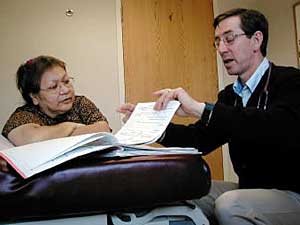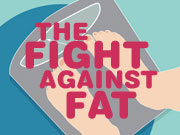|
Audio
Photos
Resources
Respond to this story
|
Obesity on the reservation
June 2, 2003
 |
| Indian health officials across the country are working hard at preventing diabetes and its complications. They want to keep people from getting the disease, and if they do have diabetes, they want them to live well. (MPR Photo/Tim Post) |
Vineland, Minn. — As you drive around the Mille Lacs reservation in central Minnesota, you can see signs of diabetes everywhere. It seems wooden wheelchair ramps lead up to the front of every other home. Almost 10 percent of the 3,300 enrolled members of the Mille Lacs band have diabetes. Dr. Fred Ness, the diabetes coordinator for the band, spends much of his time warning Native people about their risk for diabetes.
"Diabetes is the number one cause of blindness in America, it's the number one cause of kidney dialysis in America, it's the number one cause of non-tramautic amputations of feet and legs in America, it's major contributor to heart attack and stroke," Ness says.
Ness has worked with tribes across the Midwest for 20 years. In that time he's seen diabetes sneak up on Indian Country.
 | |||
"It's gotten worse for the whole time I've been in it in some way," Ness says. "We have more and more people with diabetes, and younger people with diabetes. It's definitely a public health problem."
Native Americans are three times more likely to get the disease than the country's white population. The question is why. Some say Native Americans are predisposed to diabetes, so a mainstream American diet full of calories and fat affects them even more than the general population.
Dr. Ness says yes, genetics plays a role. But it's not the only factor.
"There's a lot more psychological stress in Indian Country," according to Ness. "There's more depression, there's chemical dependency, and I see that as being key -- more than genetics."
Ness says those pyscho-social factors -- when combined with poor diets, little exercise and genetics -- put Native people at risk for diabetes. But that risk can be lowered with exercise and a healthy diet.
That's his advice to patients at the Na-Ia-Shing clinic on the Mille Lacs reservation. Anyone who's a member of a federally-recognized tribe can get care at Na-Ia-Shing. And staff members are ready to share what they know about diabetes, as a part of their effort to stem the epidemic.
 | |||
Marcy Hart is a member of the White Earth reservation. Hart lives in the Twin Cities, but drives to Mille Lacs to get care for her diabetes. She was diagnosed in 1994. Medication and a better diet have helped get her diabetes under control. Hart knows first-hand the importance of monitoring her health -- her mother died from complications of the disease.
"I know what to eat now," Hart says. "I don't go for the deep-fried pie at McDonald's, because I know it's bad for my blood sugar. If my blood sugar is up it's going to affect my body, it's going to cause damage if I keep eating like that."
That's knowledge health officials are working to get across to Native Americans. They want them to know they can live with the disease, or even prevent it altogether.
Anna Marie Bosma, the Indian Health Service diabetes coordinator for Iowa, Nebraska and the Dakotas, says in the past many Native Americans disregarded warnings about diabetes. Bosma says the way health educators delivered the message often did more harm then good.
"'If you don't change you behavior you're not going to live another five years, or you're going to be on dialysis.' That's what we call scare tactics, and it doesn't work. It just scares people into, 'I'm really sick, I might as well live while I'm alive, so I'm just going to eat all those things and there's no sense in changing my behavior,'" Bosma says.
|
There's a lot more psychological stress in Indian country. There's more depression, there's chemical dependency, and I see that as being key -- more than genetics.
- Dr. Fred Ness |
Bosma says the approach to diabetes education has changed. Health officials encourage each reservation to teach their own people about diabetes. Nationally, that's the approach the IHS prefers. Indian communities are given grants to screen for diabetes, open fitness centers or hold healthy cooking classes.
Dr. Kelly Moore with the Indian Health Service's National Diabetes program says diabetes education for Indians needs to come from Indians. She says native storytelling and traditional foods are good approaches.
"Anything that we can do that helps promote pride, anything that helps promote acceptance of themselves as Indians, and that promotes self-worth, will encourage people to feel not only better about themselves, but hopefully encourage them to make others feel better about themselves," Moore says.
There are indications the new approach to diabetes education on reservations is working. Take the Leech Lake reservation in northern Minnesota, for example. Health officials there have seen the blood sugar levels of diabetic patients decrease over the past 10 years. Over the past few years, the number of amputations caused by diabetes has gone down 75 percent.
Dr. Steve Rith-Najarian, the Leech Lake diabetes coordinator, says he's encouraged by those results, and by recent studies that show type 2 diabetes is preventable. "Now the real challenge for us is to take this more recent scientific evidence -- that you can treat diabetes outright through intensive nutrition and physical activity -- and see if we can make that a reality in our communities," Rith-Najarian says.
That won't be easy. Changing the way people eat, and encouraging them to be more active, means a change in lifestyle.
 | |||
Some Mille Lacs band members say the answer to the diabetes epidemic isn't to find a new way of life, it's to find their old way of life.
Sheldon Boyd, a commissioner for the Mille Lacs Band tribal government, says they'll do what they can to help stop diabetes. But he says ultimately it's up to each band member. He wants band members to return to traditional Ojibwe activities, like foraging, hunting and fishing -- which would provide the healthy diet and exercise they need.
"If you dedicated yourself to participating in each one of those through the season, you're pretty active. That takes care of the physical piece of you," Boyd says.
Mille Lacs Band officials say diabetes continues to be a growing problem for their people. But they say, like other Indian communities across the country, they now have the knowledge to fight the disease.
|
News Headlines
|
Related Subjects
|

